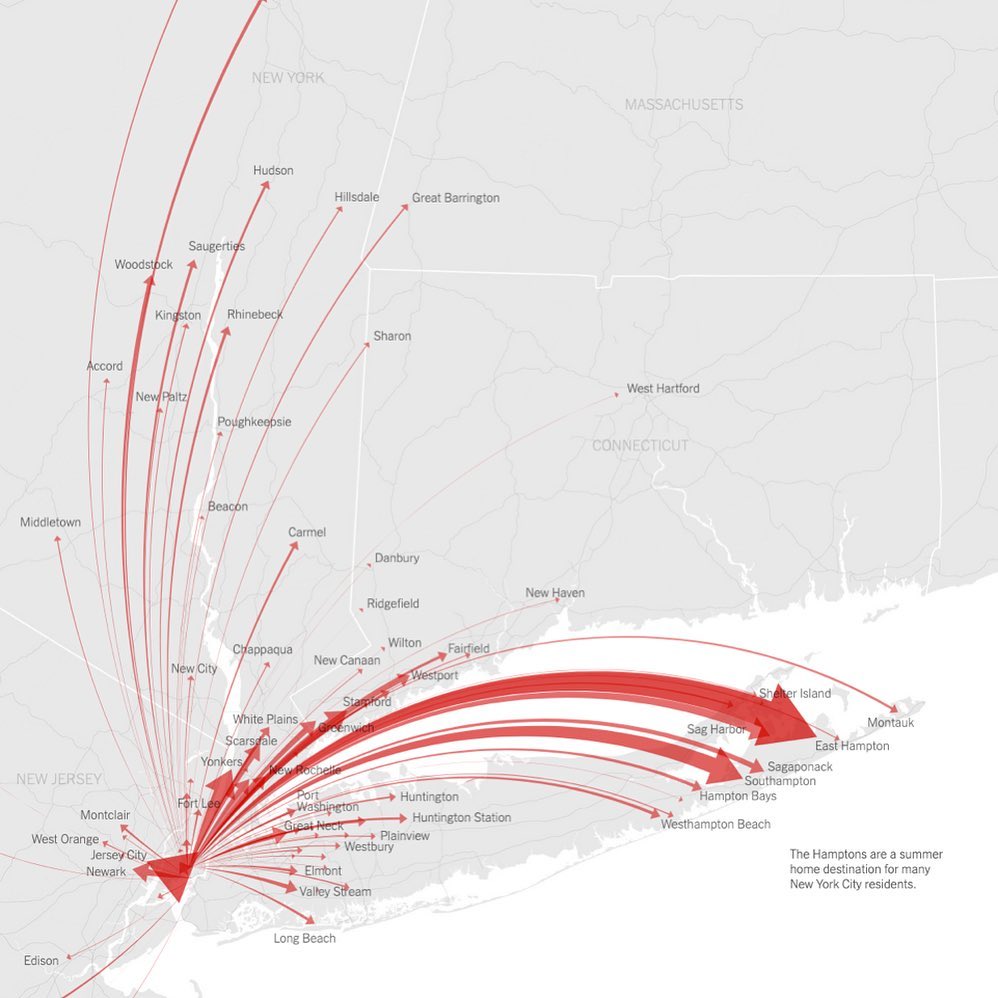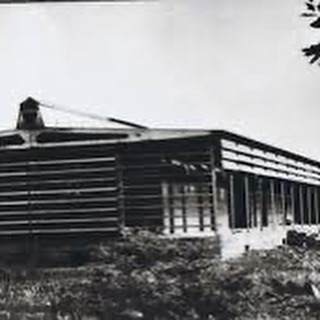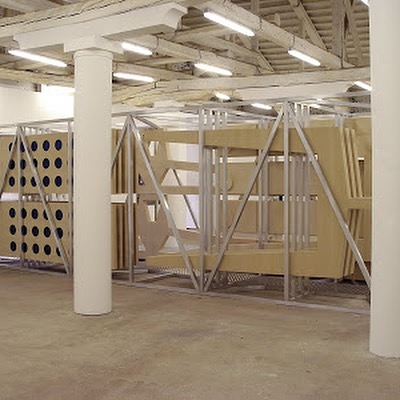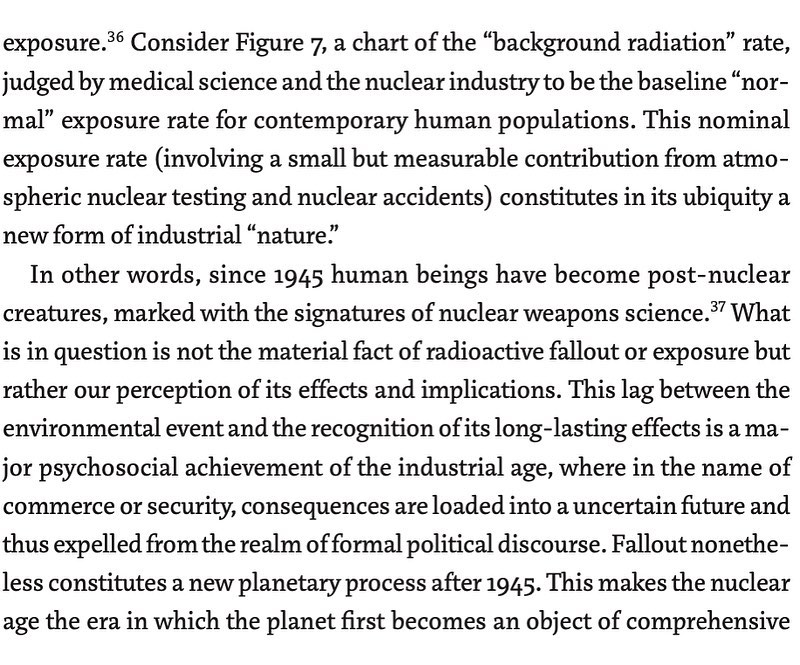(1/5) This video screen-grab by @ukc10014 is from a simulation based loosely around JG Ballard’s ‘Terminal Beach’. The synth-voice (named Sarah, property of the CereProc Corporation) narrates a Ballardian story of self-isolation: a damaged man wrecks himself on the desolate former American nuclear site of Enewetak Atoll (Marshall Islands), wandering, delirious, waiting for the end that never comes.
The simulation’s scenario, based upon Alberto Burri’s Gibellina, and test sites at Moruroa and Runit Atolls, opposes gaming’s obsession with a defined, temporally-bounded apocalyptic end (with its antecedents in Western, Judeo-Christian eschatology) to other conceptions of time, such as cyclicality in Hindu/Buddhist thought, or else — the likely scenario under climate change — a slow, painful, Hobbesian decline of civilisation.
The Jean Prouvé ‘Maison Tropicale’, designed for French colonies in West Africa, recalls the colonial and imperial ideologies that made thermonuclear testing in the Pacific islands (and Algeria) an acceptable strategy for France, America and Great Britain. Thank you to @evaandfrancomattes for making their Fukushima textures available!
As will be discussed in a subsequent video-cast, Chakrabarti views the game engine itself as a systemic medium — one that allows for novel world-making, connecting networked spaces of data (such as radiation sensors, financial market data feeds, the ‘internet-of-things’, etc.) to systems within the game, such as weather or in-game characters. In this way as well as through player agency (or lack thereof), the game engine can be seen to be a powerful critical tool, addressing the modes of media production and consumption peculiar to our historical moment.
#unrealengine #simulation #gameengine #solaris #stanislawlem #tarkovsky #paulvirilio #tts #terminalbeach #jgballard #eniwetok #moruroa #runit #nuclearculture #artinmotion #anthropocene #capitalocene #chthulucene #instalive #kanadchakrabarti #ue5 #ue4 #voicecloning #deepfake #cereproc #albertoburri #jeanprouve #maisonstropicale #marshallislands #harunfarocki
(2/5) @ukc10014 writing from Queens : `Recent pieces @nytimes (15/16 May) documented how NYC has emptied out. About 5% of the population of the city have legged it to second homes. As the article explains, there are revealing class and race aspects to the data. I wonder if, once this is (sort of) over, there will be an awkward social question we ask each other “Where did you spend the lockdown?” ‘
‘I was thinking about where these people, swaddled in their Patagonia Synchilla vests (uniform of the Midtown hedge-fund employee), might have gone. Vast clapboard manses on the strand, gazing at the Atlantic rollers, thinking of Gatsby? Perhaps they were contemplative ones, sitting at their desks, finally writing that book…see the essay @shumonbasar ‘The Eternal Return of the Primitive Hut’ which discusses the Duke of Urbino’s “studiolo”, or Buñuel’s column where St Symeon withstood the fleshy caresses of a radioactive dæmon. Alternatively, latter-day post-apocalyptics who have reserved slots in converted missile silos (@newyorker 23 Jan 2017).’
‘Settler colonialism manifest in architecture reminded me of the Jean Prouvé Maison Tropicale. Commissioned in the 1940s by an aluminium company, they were intended for the French colonies in West Africa. Light-weight and transportable by aircraft, they could be assembled by two men. Green glass portholes, a wide roof, and adjustable louvres mitigated the tropical sun. The roof’s apex concealed an axial vent, producing a cooling airflow (the doors had rotating vents). They were placed on a concrete base and the load was borne by A-frames and a central spar. (I got nerdy with the architecture while building a model in Maya 3D/Unreal Engine.)’
Anyway, the colonials for whom Prouvé designed this didn’t fancy living in them. They preferred great white houses with columns and stately rooms. The ‘évolué’ (French for Europeanised Africans) thought the whole thing was daft and wanted no part of it. Only three were built, and ended up in Niamey (Niger) and Brazzaville (Congo). Recall that the houses were made of aluminium, which was mined in countries of the Françafrique, exported for processing and then re-imported in the circular trade in commodities and consumer goods that is part of the colonial history.’
‘The loop of capital closes in the object’s after-life: a commodities trader, Robert Rubin, and an antiques dealer, Eric Touchaleaume, eventually bought/transported/re-assembled the wrecked structures, which have been shown in the US and @kanal.centrepompidou There is quite a lot available online about these houses, but Mozambican artist @angela_ferreira_ and the Malian-born NYU professor Manthia Diawara have engaged artistically with the Maison Tropicales.’
Images: (0) Kanad Chakrabarti, Untitled, 2020, Patagonia Synchilla vest, football. (1-3) Exodus, NY Times. (4) Missile bunker as condo, New Yorker. (5-7) Maison Tropicale, Failed Architecture and Wikiarquitectura. (8) Angela Ferreira’s Maison Tropicale. (9) Kanad Chakrabarti, 2020, computer simulation.
#unrealengine #simulation #gameengine #nuclearculture #artinmotion #instalive #kanadchakrabarti #ue5 #ue4 #ALightWithoutShadow #erictouchaleaume #galerie_54 #manthiadiawara #angelaferreira
(3/5) Counterpoint to the simulation shown earlier by @ukc10014, this is a talk about islands and their imperial-colonial legacies, including a reading from Edouard Glissant’s ‘Poetics of Relation’. Glissant was a Martinican contemporary of Frantz Fanon, who wrote eloquently about the condition of islanders, particularly in the Caribbean with its specific relations to Africa, the Indian Subcontinent, the American South and France. Also, readings from the Tongan/Fijian writer Epeli Hau’ofa ‘Our Sea of Islands’ — about the geographical sensibilities of Pacific islanders, and the differences, as well as commonalities, between the various island groups in the Pacific. He is often cited in the Pacific post-colonial literature, but there are many others particular to the atomic testing islands – the Marshall Islands’ Kathy Jetnil-Kijiner, Michelle Keown, the Māori poet Hone Tuwhare, as well as activists in French Polynesia such as Henri Hiro and Chantal Spitz. The images are taken by @ukc10014 in the fish market at Catania, Sicily, an island with which he has long had an artistic engagement; the computer-generated imagery is made using Processing and includes footage of American nuclear weapons tests released by Lawrence Livermore National Laboratory under a Creative Commons NC-BY-SA 4.0 license.
#eniwetok #moruroa #runit #nuclearculture #artinmotion #instalive #kanadchakrabarti #fallout #hyperobject #planetary #marshallislands #polynesiefrancaise #postnuclear #holocene #anthropocene #capitalocene #chthulucene #ALightWithoutShadow #pacificislands #epelihauofa #edouardglissant #frantzfanon #poetics #relation #edwardsaid #postcolonial #ourseaofislands #processing #catania #sicilia #ilgattopardo #giuseppetomasidilampedusa
(4/5) The mask shortage, aside from self-inflicted government failures in planning, basically comes down to a lack of ‘melt-blown non-woven’ material – resin that is extruded into a high-speed air-stream and spun into sheets. The material is breathable, but stops pollutants and pathogens, such as viral particles. Melt-blown was originally developed by the U.S. Navy in the 1950s for the nuclear weapons programme. Melt-blown filters would be carried by drones and aircraft near weapons tests in the Pacific, in order to collect radionuclides and other particles swept through the air. These were the earliest atmospheric sensors, and eventually laid the groundwork for planetary-scale climate science, as argued by Joseph Masco in ‘The Age of Fallout’ (screengrabs above)
Today, after 70 years, the planetary system incorporates a stack of inter-connected sensing and data apparatus: for instance, this radiation monitor contains WiFi and Ethernet connections that allow any computer or browser to access it. Hundreds of similar, DIY/open-source environmental monitors are deployed globally (see https://www.uradmonitor.com/). Meanwhile, government and corporate satellites collect information about the planet, for surveillance, ecological, as well as financial reasons (hedge funds are a major customer). While planetary-scale sensors are a far cry from the ocean intelligence of Lem’s Solaris, or the tentacular cunning suggested of Haraway, perhaps we can see an emergent singleton in techno-capital: the networked entity par excellence, waiting for that final transition into self-awareness.
In a simulation by @ukc10014, shown earlier in this series, sensors are hooked up to the game engine’s internal world, algorithmically altering in-game wind and weather patterns
#unrealengine #simulation #gameengine #solaris #stanislawlem #paulvirilio #tts #terminalbeach #jgballard #eniwetok #moruroa #runit #nuclearculture #artinmotion #instalive #kanadchakrabarti #ue5 #ue4 #fallout #hyperobject #planetary #marshallislands #postnuclear #thestack #benjaminbratton #holocene #anthropocene #capitalocene #chthulucene #ALightWithoutShadow #harunfarocki #posthuman #inhuman #nickbostrom #donnaharaway
(5/5) Talk about the game engine as software platform, which seems less theorised than video games themselves. Specifically, interfaces (3:50,16:00), workflows (5:00), the planetary stack (8:00), recursion (14:40), open-ness as chimera (17:45), labour conditions (20:50) and material manifestations of Unreal Engine (i.e. GPU[24:00], Amazon server instances, FX data-feeds[11:00], IoT APIs[12:50]), trying to extend Harun Farocki’s placing of games within a military-media nexus (27:00). All quite provisional & navel-gazey but hopefully get worked into an essay – DM @ukc10014 with comments. Thanks again @evaandfrancomattes for Fukushima textures (16:30)(cont’d)
Visuals: I was working on the UE4 sim & its remixes, distracted by news-flow, screen-chats, logistics of life & care, trying to ignore the existential dread that still pervades. Could barely read a book, just media OD: Chernobyl, Smiley vs Karla, the exhilarating confusion of YouTube @new_centre and PlaguePod @urbanomicdotcom — both series about the twin planetary hyper-events (plague + induced capital-coma) that maybe form a ‘hinge in history’. And I started collecting charts & memes fm Telegram & Twitter, some of which have made their way here.
#unrealengine #simulation #gameengine #paulvirilio #jgballard #artinmotion #instalive #kanadchakrabarti #ue5 #ue4 #hyperobject #planetary #thestack #benjaminbratton #ALightWithoutShadow #harunfarocki #posthuman #inhuman #nickbostrom #recursion #reflexivity #gpu #nvidia #gtx1080 #machinelearning #accelerationism #ableton #processing #maya
Kanad Chakrabarti is an artist and writer based in London and New York. He thinks of software as an heir to the film-essay, uniquely suited to the ambiguities inherent in technological capitalism.
A current project uses gaming engines to interrogate the ecological, post-colonial, and bio-political legacies of nuclear weapons testing. His practice resists market-based modes of production, preferring a nomadic, research-orientated, pedagogical approach. He has exhibited at the Queens Museum, ICA London, Nottingham Contemporary, the Whitechapel Gallery, CCA Glasgow, Shanghai Minsheng Art Museum, and the SongEun ArtSpace. He holds an MA in Painting and Art Theory from the Slade School of Fine Art (UCL, 2015) and a BSc in Computer Science (MIT, 1994).




















